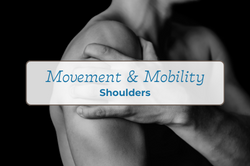
“With great mobility comes great responsibility.”
~ Uncle Ben
Okay, well, maybe that’s not the EXACT quote – but I’m sure Spiderman would 10/10 recommend taking good care of your shoulders!
The shoulder is one of the most mobile joints in the body, allowing the arm to move in multiple directions. The shoulder is classified as a ball-and-socket joint, but, unlike the hip joint, where the head of the femur fully rests in the socket (acetabulum) of the pelvis, the head of the humerus (upper arm bone) rests against the glenoid fossa of the scapula much like a golf ball rests on a golf tee.
It’s important to maintain mobility in the shoulder. It’s the one joint that you don’t want to immobilize, unless there’s a serious injury (of course, always check with your healthcare provider for medical advice specific to your situation). If the shoulder’s just a wee bit sore or feeling restricted, it’s okay to continuing strengthening and stretching and moving.
Here are a couple of exercises to help keep those shoulders happy:
Alternating Arm Raises
- Hold your resistance band at either end – adjust the amount of tension on the band so that you have some resistance and enough slack to get full range of motion
- Alternate raising your left and right arms forward and up – allow your arm to reach back as far as you are able
- Inhale when you raise your arm and exhale when you lower it – combining breath with motion will help keep you mindful so you don’t overstretch.
- Do 2 to 3 sets of 8-10 reps – 1 rep is a full round of both left and right
Dowel Dislocator
The name of this exercise sounds painful – but it is really a great move for opening up the shoulder area and getting circulation into the joint. You can use a dowel, broomstick, PVC pipe, or a resistance band.
- Hold your band at either end – adjust the amount of tension on the band so that you have some resistance and enough slack to get full range of motion
- Keeping your arms wide – lift forward, up, over and back
- Bring your arms back over the front starting position
- Do 2 to 3 sets of 8-10 reps – 1 rep is a full round forward and back
—
Shoulder Muscles
The shoulder joint is a fairly complex structure, with 20 different muscles either directly crossing the joint or indirectly affecting the joint. If you really want to dive into the anatomy, here’s an overview of the shoulder muscles:
Muscles that stabilize the shoulder joint – The shoulder joint is stabilized primarily by the four muscles that comprise the rotator cuff. An easy way to remember which muscles make up the rotator cuff is the acronym SITS:
- S – Supraspinatus: abducts the arm for the first 15 degrees of movement, then assists the deltoid to further abduct the arm up to 90 degrees.
- I – Infraspinatus: rotates the arm laterally
- T – Teres Minor: rotates the arm laterally
- S – Subscapularis: rotates the arm medially (assisted by the pec major)
Muscles that are the prime movers of the arm
- Pectoralis Major: flexes and adducts the arm, rotates the arm medially – when you slouch, your arms roll in and pecs are working overtime!
- Latissimus Dorsi: extends and adducts the arm, medially rotates the arm
- Deltoids (anterior, middle, and posterior): abducts the arm; also flexes and medially rotates the arm (anterior delt) and extends and laterally rotates the arm (posterior delt)
Muscles that are synergists to the prime movers
- Rotator Cuff muscles
- Teres Major: extends, medially rotates, and adducts the arm
- Coracobrachialis: flexes and adducts the arm
Muscles that move the scapula and arm
- Pectoralis Minor: pulls scapula forward and down
- Serratus Anterior: rotates scapula laterally and upward
- Subclavius: stabilizes and depresses the pectoral girdle
- Trapezius: stabilizes, raises, retracts, and rotates the scapula
- Levator Scapula: elevates the scapula (i.e., the upward motion of shrugging the shoulders)
- Rhomboids (major and minor): stabilizes and retracts the scapula (i.e., squaring the shoulders)
Muscles that cross the shoulder and elbow joint – The biceps and triceps might not be the first muscles that come to mind when considering shoulder muscles, but both attach to the scapula and cross the elbow joint as well.
- Biceps Brachii – flexes elbow joint and supinates the arm
- Triceps Brachii – extends the forearm, stabilizes the shoulders, assists in arm adduction
Planes of Motion
- abduct – moves away from the body
- adduct – moves towards the body
- medial – towards the middle of the body
- lateral – towards the edges of the body
- supinate – turn or hold upwards
CITATION: Marieb, E. N., & Hoehn, K. (2013). Human Anatomy & Physiology. Pearson.
